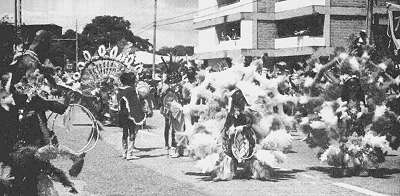 with no European Spaniards available for emigration, it invited West Indian French Catholics dissatisfied by Britain's 1763 take-over of their Antillian islands - Grenada, Dominica, St Vincent, Tobago to settle in Trinidad. They were encouraged by land grants to set up agricultural units under their own management and to transfer slaves in quantity to work these plantations.
with no European Spaniards available for emigration, it invited West Indian French Catholics dissatisfied by Britain's 1763 take-over of their Antillian islands - Grenada, Dominica, St Vincent, Tobago to settle in Trinidad. They were encouraged by land grants to set up agricultural units under their own management and to transfer slaves in quantity to work these plantations.
Influenced by France, but also set on maintaining Spanish control and the Roman Catholic faith in his American colonies, Charles III extended this provision in 1783 by issuing a further Cedula de Poblacion. This allowed any Catholic to settle in Trinidad providing he agreed to stipulated immigration conditions, including a loyalty oath to the Spanish crown. ![]() 1
1
At this point the island's population was very small indeed, comprising Spanish-speaking whites, coloureds, slaves and Indians and, as has been pointed out by Andrew Pearse in his study of 'Carnival in Nineteenth Century Trinidad', because there is no concrete evidence for the existence of an annual Shrovetide festival before this date, 1783 is a convenient neutral starting point for discussing the development of the Trinidad Carnival. ![]() 2
2
Over the next fourteen years, due to the unsettled times in the Caribbean - the British having taken control of most of the French West Indian islands in the latter part of the eighteenth century - a great number of French planters grasped the opportunity to settle in Trinidad, bringing their slaves with them. In consequence, when in 1797 the British took Trinidad itself, there was a significantly French-speaking and mainly Creole population. The French whites had established themselves as a landed aristocracy and using the labour of their black slaves had created flourishing plantations growing tobacco, sugar, cotton, and coffee.
It has been necessary to outline the sequence of French settlement in Trinidad because of its utmost importance in establishing the Shrovetide celebration of Carnival on the island - at least as far as the written record is concerned. Despite a large and speedy increase in population - in particular from the Spanish Main, North America, Africa, and the British West Indian islands - and, indeed, some French emigration, the French community remained in control of the island's economic core and, thus, were able to stamp their cultural characteristics on its ensuing festive developments. Following emancipation, in 1833, peoples from the Near-East, Indian subcontinent and the Orient were to increase further the population and cultural-mix.
With respect to slave culture at this time, the findings of B W Higman are relevant. In the second of five points concluding his discussion of 'African and Creole Slave Family Patterns in Trinidad', he notes that 'Distinct African ethnic/tribal groups lost their identity almost immediately as a result of extensive intermarriage. 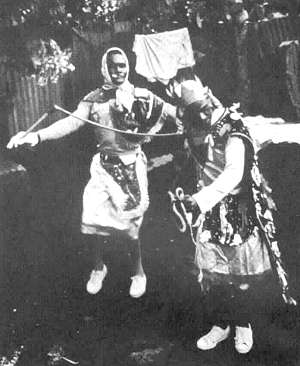 Only those groups which constituted a substantial proportion of the total slave population, and had a relatively natural sex ratio, were able to establish family patterns which reflected however vaguely their particular [African] cultural history'.
Only those groups which constituted a substantial proportion of the total slave population, and had a relatively natural sex ratio, were able to establish family patterns which reflected however vaguely their particular [African] cultural history'.
Thus, the cultural influence of French Creole slaves would, almost certainly, have been dominant over those arriving direct from Africa and, as the former were in greatest preponderance, this was of first importance in establishing their own syncretic Afro-French culture in Trinidad. The free coloureds too, would have come under this overwhelming French and Afro-French influence. ![]() 3
3
Afro-French syncretism in the Caribbean requires a great deal of further research but it is useful at this point to draw attention to Dena J Epstein's documentation of the dance called la calinda, together with its associated instrument the banza (banjo), both African in origin, which she demonstrates persist from the original seventeenth-century colonisation of the British and French West Indies to the mid-nineteenth century (the period of her research). There are several French reports of West Indian blacks dancing the calinda; a dance which may or may not have received its name from the Roman first day of the month or season - the calends (or kalends) which, in the case of seasonal change, was usually celebrated by festivities. ![]() 4
4
The unusually French character of late-eighteenth- and early nineteenth-century Trinidadian culture, among both blacks and whites, was observed throughout this period, and later even in his important Colonial Office memo on 'History of the Origin of the Carnival' (1881), one-time Head of Police, L M Fraser, states with surprise that, 'in an island which never belonged to France for even a single day the French element ... largely predominates'. In order, therefore, to understand the place of Carnival in Trinidad society, the origins and traditions of Southern European Carnival require some exploration. ![]() 5
5
The general assumption on the origin of European Carnival, founded on the work of J G Frazer, has been that it is based on the New Year Roman festival of the Kalends of January, which it is said, spread throughout the Roman empire and, 'was celebrated by the relaxation of all ordinary rules of conduct and the inversion of customary social status'. This season, in turn, close to the similar Roman ploughing and sowing festival of Saturnalia, and other earlier pagan fertility rites (also identified by Frazer), was adopted by the Catholic church - witness the days of Christian celebration between All Souls Day (2 November) and Candlemas (2 February). The Christmas festival is sometimes said to extend across this period and, by some, even to the time of Shrovetide Carnival. More often than not, certainly in early Modern Europe, the Carnival season lasted from Christmas to Shrove Tuesday and this time-scale was also adopted by the eighteenth-century French settlers of Trinidad. ![]() 6
6
Although he accepts that, 'no Carnival was like any other Carnival', historian Peter Burke's discussion of these festivities in early Modern Europe, points up common elements in such celebrations. Burke identifies four 'less formally structured- events which went on intermittently through the carnival season':
In this Burke sees this period of European Carnival as, 'not only a festival of aggression, of destruction, desecration. Indeed, one should perhaps think of sex as the middle term connecting food and violence. The violence, like the sex, was more or less sublimated into ritual. Verbal aggression was licensed at this season, maskers were allowed to insult individuals, to criticise the authorities'. ![]() 7
7
If these elements were usual throughout the Carnival period and, in particular, at the event of Carnival itself, the reasons for their seasonal occurrence must be examined. Perhaps the most satisfactory explanation for the focal point of festivals when 'the world is turned upside-down' is the rites of passage model conceived by French folklorist Arnold Van Gennep to describe the key ceremonial stages in the life of an individual or individuals. Each rite is delineated by three phases (sometimes not in this order):
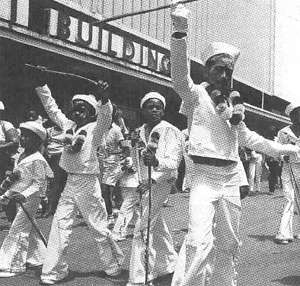 Yet, the reasons as to why Carnival and, to a lesser extent, other seasonal rites should have been and continue to be such a focal point for communal 'misrule' are, perhaps, not so easily defined for, as Peter Burke points out, 'What is clear is that Carnival was polysemous, meaning different things to different people'.
Yet, the reasons as to why Carnival and, to a lesser extent, other seasonal rites should have been and continue to be such a focal point for communal 'misrule' are, perhaps, not so easily defined for, as Peter Burke points out, 'What is clear is that Carnival was polysemous, meaning different things to different people'.
The functionalist view of Carnival is that it serves as a safety-valve in a politically repressive society - in other words it is part of a system of social control. In given circumstances, this argument appears the most satisfactory explanation; certainly, Carnival was probably viewed in this light by hierarchies in early Modern Europe and, indeed, by white plantation-owning societies in the West Indies. But, as French historian Emmanuel Le Roy Laudrie has indicated, others saw Carnival as a time when social change might be effected or, at the very least, influenced. Folklorists Roger D Abrahams and Richard Bauman express another view of the role of such festivities in two twentieth-century communities - the West Indian island of St Vincent (Carnival) and the Le Havre Islands, Nova Scotia (Christmas belsnickling - 'mumming'): 'Far from constituting events that have hostility and conflict as their organising principle, carnival and belsnickling appear to us to draw together opposing elements in the two societies in which they occur and to draw them together more closely and harmoniously than at any time in the year'. ![]() 9
9
Indirectly, this returns us to the celebration of Carnival in the West Indies. Simply because they ruled Trinidad from 1797 (until Independence in 1962), the most important secondary cultural contribution to its Carnival came from the British and Afro-British inhabitants. Like the French before them, British masters, together with their Creole slaves, came to Trinidad from other islands in the West Indian archipelago to establish and operate plantations - although, as indicated, they did this without disturbing the island's overall French cultural hegemony.
The black folklore traditions of the British West Indies have been the subject of considerable research by Roger D Abrahams. Explaining the traditional times for festive celebration in the English-speaking territories he notes: 'In the eastern Caribbean where there was little influence from the Catholic (French and Spanish) islands, Christmas was the traditional time of freedom and licence for the slaves - so much so that their other major holiday, Easter, was often called 'Pickininny Christmas'. Thus on islands like Jamaica, Nevis, St. Kitts, Antigua and Barbados, the formal and licentious types of ceremonies were commingled in the observation of the Christmas season though revelry certainly was the more important activity. In the more southern islands, most of which were at some time under French rule, Carnival is also played, thus creating the situation where motives of formality and decorousness could be attached to one celebration [Christmas], 'nonsense' and revelry the other [Carnival]'. Abrahams points out that the latter is the situation on St Vincent. ![]() 10
10
If there were seasonal times in the British and, for that matter, the French West Indies, when slaves could engage in musical activities and there was at least one focal point in the year, Christmas Carnival or both, when more elaborate rituals were allowed, the question arises as to what was the African contribution to both the music and the ceremonies. Clearly, almost wholesale adoption as well as adaptation of European traditions occurred hence the performance by blacks of British mummers' plays and other Christmas customs. But, as there remains a strong tradition of masquerade in West Africa these might well have paralleled customs that slaves recalled from the traditional societies whence they came, and have been adopted simply because they served the same purpose. In light, however, of the careful analysis of Sidney Mintz and Richard Price, in their discourse on 'An Anthropological Approach to the Afro-American Past', this is probably too simplistic model for the complicated development of cultural norms. Notwithstanding, what must be stated is that there is a strong and obvious African component in Carnival, and carnivalesque, based on 'creativity and innovation' rather than particularities of 'content' characteristics of Afro-American cultures identified by Sidney Mintz. ![]() 11
11
In its initial period (1784-l833), Andrew Pearse points out that the Trinidad 'Carnival was an important institution for Whites and Free Coloured, particularly in the towns'. However, their communal involvement in the festival was gradually changed by the British take-over of the island in 1797. 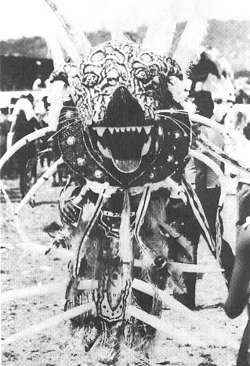 Firstly, there was progressive discrimination against the free coloureds by the white British administration and, secondly, as Christmas had functioned as the carnivalesque focal point in the British West Indies there was an endeavour to emphasise this festival over and above the celebration of Carnival itself: from which, in any case, the slaves remained virtually excluded. At Christmas, Martial Law was declared (this included manoeuvres by the militia), there were parties stressing social prestige, Church attendance was expected, and slaves were given universal licence 'for dancing, feasting at the master's expense, some freedom of movement, and elaborate costuming'.
Firstly, there was progressive discrimination against the free coloureds by the white British administration and, secondly, as Christmas had functioned as the carnivalesque focal point in the British West Indies there was an endeavour to emphasise this festival over and above the celebration of Carnival itself: from which, in any case, the slaves remained virtually excluded. At Christmas, Martial Law was declared (this included manoeuvres by the militia), there were parties stressing social prestige, Church attendance was expected, and slaves were given universal licence 'for dancing, feasting at the master's expense, some freedom of movement, and elaborate costuming'. ![]() 12
12
Whether Christmas or Carnival, when whites and coloureds masqueraded, the celebrations fit closely the 'rites of passage' model of Van Gennep and the various socially symbolic structures and functions which Carnival and carnivalesque have been shown to perform. And, although the circumstances alter, this can also be shown to be true for Carnival after the freedom of the slaves in 1833.
From this point it was Carnival that became the principal annual celebration for freed slaves and others in the lower classes. That it performed the role of satirical parody and other rituals associated with the masquerade, in both European and African settings, is witnessed by contemporary newspaper reports. These show the usual elements of communal 'misrule', with an emphasis on sex and violence, and their effect of disturbing the social norm was well taken by the ruling white elite. As the latter withdrew from public participation in Carnival so too did the newspaper reports of the event become more and more hostile, emphasising the class distinctions of the time - the elite electing for a manifest separate 'superiority'. ![]() 13
13
Although the white elite made it clear that they were generally hostile to the 'challenge' of Carnival, the attitude of the coloured middle-class poses more of a problem. On the basis of his research, Andrew Pearse finds that:
'The degree of [their] participation ... is difficult to ascertain. The evidence seems to point to the following situations: (1) Carnival remained for them an important season of festivity and sociality ... (2) Whilst avoiding association in the streets with the masses this class was deeply resentful of any interference with Carnival by the Government and was ready to use it if necessary as a means of indirect attack on the Governor and the upper (white) class whenever tension rose'.This too fits the picture of a Carnival season the function and structure of which varied from year to year depending on the social conditions appertaining.
Before proceeding, mention must be made of the 'canboulay' ritual which appears to have originated in the white community prior to slavery's abolition and then to have been adopted by the blacks as a first of August celebration of their 1833 emancipation. It was later transferred to the occasion of Carnival.
According to a letter published in an 1881 edition of the 'Port of Spain Gazette' (26 March), canboulay seems to have started as a Carnival masquerade in which, prior to emancipation, whites dressed up as blacks, imitated their dances (including the calinda) and their torch-lit, drum accompanied procedures which had originated in practices designed to cope with the emergency of a sugar cane plantation fire - hence cannes brulees (canboulay). Whether or not whites did perform this masquerade (this is the only report), what is certain is that the rituals that blacks adopted midnight processions, with torches, drumming and singing - were full of symbolic meaning and eminently in the Carnival tradition, It is important to note that one of the dances mentioned was the calinda. This, as has been pointed out, was of African origin and, as far as black Trinidadians were concerned, was associated both with stick fighting/dancing and (in its vocal version) satirical song. Understandably, the calinda was of great significance to the black community in their adoption of Carnival as an annual positive statement of social integrity. ![]() 15
15
In time the canboulay parade came to initiate Carnival celebrations: it began at midnight on the Monday of festivities as, by 1841, Sunday revelry had been prohibited on account of desecration of the Sabbath. 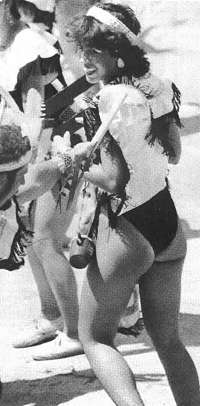 From the mid-1850's, newspaper reports are directed increasingly against the festival as creating an unwarranted disturbance, with canboulay becoming one of the major points of friction. During the same period, certainly as far as the controlling white elite were concerned, the character of Carnival celebrants changed more and more to represent the jamette - a class word for diametre or diamet, applied to those beneath the 'diameter' of reputable society i.e. the underworld. Clearly this led to greater polarisation on both sides and a clash of the two opposing values became inevitable. As with early Modern European examples already referred to and, indeed, late-1840's-early 1850's Carnival protestations at the time of the Second French Republic, the meaning of Carnival took on special symbolic significance at a time of social and, or, political tension.
From the mid-1850's, newspaper reports are directed increasingly against the festival as creating an unwarranted disturbance, with canboulay becoming one of the major points of friction. During the same period, certainly as far as the controlling white elite were concerned, the character of Carnival celebrants changed more and more to represent the jamette - a class word for diametre or diamet, applied to those beneath the 'diameter' of reputable society i.e. the underworld. Clearly this led to greater polarisation on both sides and a clash of the two opposing values became inevitable. As with early Modern European examples already referred to and, indeed, late-1840's-early 1850's Carnival protestations at the time of the Second French Republic, the meaning of Carnival took on special symbolic significance at a time of social and, or, political tension. ![]() 16
16
In Trinidad, matters came to a head in the late 1870s when the aforementioned moderate Chief of Police, L M Fraser, was dismissed and the tough Captain Baker was appointed in his place. His measures led, ultimately, to confrontation. In 1878 and 1879 Baker's actions were circumspect enough to avoid a direct challenge to the ceremony but in 1880 he attempted to suppress canboulay by calling on the paraders to surrender their sticks, drums and lighted torches. They acquiesced but in the following year prepared themselves to resist more vigorously, for they believed that Baker's moves were part of a concerted effort to abolish both canboulay and Carnival. As a consequence in 1881, canboulay was put down with violence which, almost certainly, would have become worse had not the astute Governor of the colony confined police to barracks for Shrove Monday and Tuesday and appealed to the masqueraders direct. ![]() 17
17
Serious trouble continued for at least two more years: 'The official view was that the Carnival of 1883 was even more disorderly than that of 1881. The reports tell of fighting, throwing of stones and bottles, much obscenity and unmasked bands of disorderly persons through Port-of-Spain armed with long sticks'. But the Governor's direct appeal to the maskers signalled a change of attitude among the colonial hierarchy who, from then on, consciously moved towards greater participation in the festivities. In this, Carnival had succeeded in effecting much needed social change and the Government, realising its social implications, came to accord it official recognition. ![]() 18
18
Nevertheless canboulay was abolished in 1884 by an order fixing the commencement of Carnival to 6 a.m. on Mondays; bands of more than ten carrying sticks were forbidden; Pierrot maskers were obliged to obtain a police licence; and pisse-en-lit bands (men dressed as women) together with the obscene words and actions in which they specialised, were prohibited. This stricter control, however, was accompanied by the greater participation of the white elite and, as has been noted, a recognition of the 'people' and their annual festival. In this, Carnival's function was changed structurally from one combining binary opposites, to one embodying binary affinities: from emphasising society's stratifications, to drawing together gradually these disparate elements. In this role it has continued. ![]() 19
19
It remains to note briefly the relationship of kaiso or, calypso, Trinidad Carnival's satiric song tradition, to the event itself. Firstly, it must be emphasised that satire and satiric song are a feature of Carnival occasions worldwide. Secondly, there is a marked tradition of satiric song in African and Afro-American societies. These, coupled with Afro-American traditions of ceremony and eloquence, are the folk-loric foundations for this famous and popular song form. Clearly, with such roots, calypso relates closely to the tradition of Carnival itself and, more specifically to the rivalry still maintained between bands of masqueraders. Formerly, the most overt reflection of this competitiveness was the stick band, which fought ritualistically to the musical accompaniment of the calinda/kalinda - both danced, and sung (originally in French patois). And, although calypso is more than just a style of challenge song, the latter forms the most tenuous link between it and celebrations of Carnival past and present. ![]() 20
20
John Cowley
Article MT117
| Top of page | Articles | Home Page | Reviews | News | Editorial | Map |